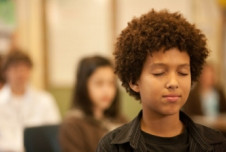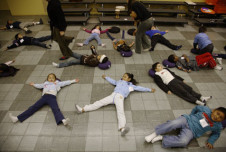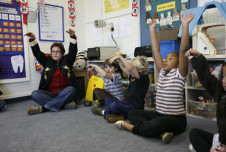“You know, I hate school. I hate it because you’re not allowed to beat the people up here that bother you. I can’t take care of the things I want to.”
That summed up Tralin’s attitudes toward her school at the start of second grade. She did not feel secure in her relationships to her teacher or her peers. She showed little care for the well-being of others or her classroom as a whole. And she definitely was not alone.
For a variety of reasons, many children like Tralin, especially those in schools serving children in poverty, do not experience their classrooms and schools as caring communities. Often, both teachers and students report that they do not find schools to be caring places. Instead of serving to teach values like compassion, tolerance, and under-standing, this atmosphere reinforces their opposites. Such conditions severely challenge a teacher’s ability to conduct even the most basic of academic lessons. No one wants this state of affairs, no one gains from it, and it does not have to be so.
Luckily for Tralin, Laura Ecken was her teacher. I met Laura through her school’s involvement with the Child Development Project (CDP), the research-tested school improvement program of which I was program director. CDP is one of a number of comprehensive educational programs that focus on ways to help schools foster students’ social, emotional, and moral, as well as intellectual, development. Though CDP has changed over the years, it remains rooted in a mission to help teachers create caring classroom communities.
In its most ambitious form, CDP involves a program of collaborative learning activities, regular class meetings, and a relationship-based approach to classroom management. This approach, called Developmental Discipline, involves building friendly relationships with and among students; teaching social, emotional, and moral skills and understandings so that children can play an active role in navigating difficult classroom decisions; and using non-coercive, empathy inducing responses to student misbehavior—in other words, encouraging children to recognize for themselves how their actions affect their classmates. Recent studies have connected CDP and other programs focused on students’ social and emotional learning not only to improved behavior in students, but to improved academic achievement as well. (Click here for more details.)
Because Laura Ecken taught a combined second-third grade classroom, she and her students stayed together for two consecutive years. Over this time I worked with Laura to implement the CDP model. Gradually, Laura was able to help Tralin and her classmates see themselves as members of a classroom community built on trust, compassion, and respect for self and others. How did this happen?
Creating a caring classroom
Laura knew that a sizable number of her students had had an insecure relationship with their parents or caregivers and were entering her classroom viewing her and the world with untrusting eyes. Like Tralin, these students are likely to believe that they need to fend for themselves to meet their basic needs; compassion simply isn’t featured in their emotional vocabulary. Laura further understood that her students wanted and needed the same things to function well in the classroom—to feel a sense of belonging, maintain a nurturing relationship with her, experience a reasonable amount of freedom, and be and be seen as competent at different tasks. And she knew that some would appear angry and aggressive until she could help them meet these needs.
Recognizing this, Laura set out from the first day of school to build trusting, caring relationships with and among her students. She helped them get to know small personal things about one another and see and appreciate one another’s strengths. Her effort to get to know and personally connect with all her students was ongoing. For example, she had lunch with small groups of students every day and had ordinary conversations with them about things they were interested in. She made a point of doing nice things for them: she made root beer floats for their parties and frequently brought them books related to their special interests; once when her student Cindy was afraid that no one would be able to pick her up from daycare, Laura gave Cindy her phone number, assuring her that she would come and get her if her foster mother could not.
Laura worked hard to build her students’ academic skills while also providing them with many opportunities to exercise choice in their learning. When she needed to redirect or control their unacceptable behavior, she used the least coercive means available. She involved her students in conversation and reflection on moral and social, as well as academic, issues, and helped them see that “school’s not just learning how to read and write,” as she liked to say, “it’s also learning about how to live your life.” Perhaps most importantly, she believed in the worthiness of each child and clearly conveyed that belief to her students.
Because her students had different temperaments and different levels of skills, knowledge, and trust, how Laura accomplished these goals varied with each child. To gain a clearer and more concrete picture of Laura’s approach, let’s look at some actual interactions between Laura and Tralin over their two years together.
Tralin’s transformation
Beyond her struggles with peer relationships, Tralin had considerable difficulty with the academic curriculum. She often whined about learning activities and resisted engagement. At first, Laura saw Tralin as defiant and lazy. Early in their first year together, Laura told me, “I’ve got a problem with Tralin. No matter what I say we’re going to do, no matter what ... Tralin will say, ‘It’s boring. I don’t want to do this. I wish I was at another school.’”
At this point in her relationship with Tralin, Laura was frustrated. She decided to call Tralin’s grandmother for a three-way conference. The outcome was instructive, she explained to me.
It turns out Tralin is really upset about not knowing how to read well and not knowing what to do [in class]. So we made an agreement that when the class goes into partner work, I will visit her partnership first to make sure that they’re clear on what the directions are and to give them some help if they need it to get started. Tralin agreed to quit moaning and groaning, even when the work looks too hard.
That’s worked out a lot better. A couple of times she’s started whining and I just very quietly say, “Remember, we have an agreement. Anything you need help with, I’ll help you.”
Once Laura realized that Tralin’s resistance to learning activities was not defiance or laziness but her lack of competence and confidence, Laura was better able to provide Tralin with the support she needed to persevere and succeed at academic tasks. Gradually, as she gained skills and confidence, Tralin became a more willing student; as her trust in Laura grew, she became more willing to seek and accept Laura’s help. This shift in Tralin’s attitude, as well as Laura’s efforts to establish a supportive partnership with her, are illustrated by this next incident that took place near the beginning of Tralin’s second year in Laura’s classroom. The children were in the cafeteria and Laura was trying to get her class out of the cafeteria to make room for the next group of students.
Tralin shoved another student,Tyrone, so she could stand in line near her friend Ella.
Tyrone came up and told me what happened, so I went back and said, “Tralin, we don’t treat people like that in this classroom.”
She called Tyrone a liar, and I said, “No, it’s his place in the line, so get in line.We’re heading outside.”
Before we could get all the way outside, she was screaming at Tyrone, “Your mom uses crack cocaine! Your mom’s a crackhead!”
I asked her to just step aside so we could talk. I asked her why she had called his mother that, and she said, “Because she is and he lied on me and said I pushed him out of the line and I didn’t touch him.”
I said,“You know,Tralin, you’re lying to yourself. I saw you push him out of the line.You wanted to be with Ella and so you shoved him out of the way.
“You know I’m not going to allow that, and I’m not going to allow you to call his mother names. Can you imagine how painful it is for Tyrone to know that about his mother, to suffer all the pain from that, and then to have to be at school and have you make his pain even worse? That’s just not right.”
I asked her if she thought that maybe we ought to call Granny and let her know that this is what she’s doing in school. . . .
Here Laura was tempted to use a coercive strategy, calling Tralin’s grandmother. Such a step, in this instance, would have been upsetting to both Tralin and her grandmother. But then Laura thought better of it. She continued,
But what really needed to happen, I thought, was for Tralin to make it up to Tyrone in some way. I said, “You know, you said some ugly things to Tyrone and I think it’d probably be best to take care of that.”
She just looked at me, so I said, “When you have a plan, just find me and let me know, but I think that you should take care of it before the day’s over.”
While Tralin had no choice about repairing the harm she had caused Tyrone, Laura supported her sense of autonomy by leaving the plan up to her and trusting that she would follow through.
About an hour later Tralin came up to me and kind of stood there, so I asked her if she had a plan. She said, “I need to tell him that I’m sorry and that I didn’t mean any of it. I was just mad and that’s why I said it.”
I asked her if she wanted him to come out in the hall so she could tell him that privately, and she said, “Yeah, but first I need a drink.”
I told her, “Listen, you go get a drink and I’ll tell Tyrone you want to talk to him in the hall.”
When Tyrone came back in, he was happy and so was Tralin.
Tralin told me, “He said it was all right.”
I said, “You know, next time you get mad about something, tell the person why you’re mad. That’s your best course of action. So they understand why you’re upset.”
Notice how collaborative and respectful this interaction was, without being weak or lacking in the clear exercise of authority. Also notice that Tralin, while still having a lot to learn about controlling her emotions and treating her classmates kindly, was able to reflect on her own actions, admit her part in an altercation, empathize with the distress she had caused another, and engage in the moral act of restitution. The research of psychologist Martin Hoffman, among others, has shown that helping children through this process is far superior to punishment in fostering moral behavior. At this point in their relationship, Laura was able to support Tralin’s moral development and teach her important interpersonal skills, something she clearly could not do when Tralin first arrived in her classroom.
Tralin’s progress continued through the end of her second year with Laura. When she and Kenny, a student from another class, were on a field trip together, Laura told me,
Kenny started to whine and cry, “I’m so tired, I don’t want to do anything else.”
Tralin said to him, “I’m tired, too, Kenny, but I’m just saying in my mind, ‘We’re going to see stuff here and let’s go do it.’”
Self-talk, or telling oneself what to do, is a skill that Laura had explicitly taught her students. She continued,
I asked Tralin, “Do you really feel like you want to whine and cry right now?”
She said, “Yes, I’m really tired, but I’m telling myself not to do it.”
I said to Kenny, “What Tralin’s doing, that’s something you can do when you’re really tired but you still know that you’ve got stuff to do.”
It must have made sense to him. He recovered himself and we had a really nice time.
Clearly Tralin had undergone a transformation. Gone was the angry, aggressive, and untrusting child who whined about learning activities. In her place was a self-aware and morally responsible child who could reflect on her own behavior and genuinely apologize for her actions—a persevering, friendly, and successful child trying to learn as much as she could.
This transformation took two years. It is the kind of transformation that needed to occur for Tralin’s success as a learner and happiness as a person. It is the kind of transformation that can happen when children experience their classrooms as caring communities. Laura Ecken created this kind of classroom for Tralin. She trusted in the potential goodness and desire to learn of all her students and made a conscious effort to convey that trust to them. She took the time to teach the social, emotional, and moral skills and understandings her students needed to treat one another kindly, and she adjusted her demands and support to each child’s existing social, emotional, moral, and intellectual levels.
Such communities are possible in every school setting. But achieving them requires that educators see teaching as a collaborative enterprise, trusting in the (sometimes deeply hidden) intrinsic motivation of their students to learn and belong, and making the extra effort to build trust with children who appear angry and aggressive or overly demanding and dependant. It also requires that we resist the current exhortations to focus narrowly on the academic curriculum. For in caring school communities, students are more likely to develop concern for the rights and feelings of others, positive attitudes toward their school, a commitment to democratic values, and the motivation to take their schoolwork seriously. The benefit of this approach is not only to make kids feel cared for, but to raise them as people who are emotionally and intellectually capable of caring for others—the type of people we’d want to care for us.




Comments